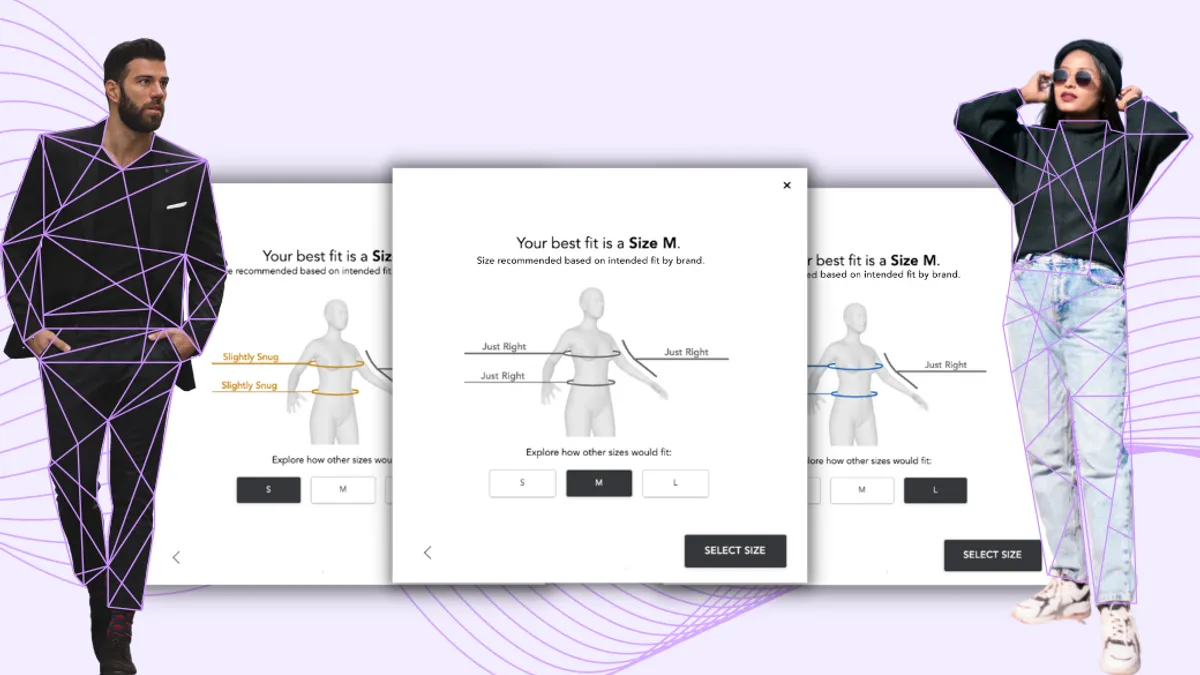In today's rapidly evolving apparel landscape, technology is playing an increasingly pivotal role in how apparel brands approach size and fit. From digital twins to virtual try-ons and avatars, there's a wealth of innovative solutions available to help brands better understand and meet the needs of their customers.
While size charts and brand comparison tools may serve as a starting point for consumers and brands navigating apparel sizing, they are often limited in their accuracy, standardization and personalization. To overcome these limitations and provide a more seamless and personalized shopping experience, brands can explore innovative size and fit technology solutions such as virtual try-ons, digital twins and generative AI. These technologies offer more accurate and tailored sizing recommendations, ultimately improving customer satisfaction and loyalty. For brands looking to move beyond size charts and brand comparison tools, here are five key considerations to keep in mind while evaluating size and fit solutions.
1. A personalized, customer-centric approach
Central to any successful size-and-fit technology strategy is a deep understanding and focus on the customer. Sizing technologies that leverage shopper body data paired with product information and purchase and returns behaviors, can provide brands valuable insights into their actual customer's actions, preferences, their consumers’ body shapes and sizing requirements. For example, sizing solutions that provide multiple recommendations and visualize fit across key points of measurement, allow shoppers to understand how clothing will fit them, accommodating the shopper's unique fit and sizing preferences. This customer-centric approach allows brands to tailor their sizing solutions to meet the unique needs of their customers, ultimately leading to higher satisfaction, loyalty and reduced returns.
2. Accuracy and consistency
One of the biggest challenges in apparel sizing is ensuring accuracy and consistency across different products and brands. Size and fit technology solutions, such as digital twins paired with generative AI, deliver precise and reliable results to instill confidence in customers and minimize the risk of returns. Brands should carefully evaluate the accuracy and consistency of any sizing solution before implementation. Solutions that accommodate tech-pack level garment data, such as fabric, ease and intended fit by design, can separate themselves from the competition due to their level of granularity and detail.
3. Adoption and ease of use
In an increasingly digital landscape, brands must prioritize the adoption and ease of use of sizing technology solutions. This entails selecting technologies that are intuitive and user-friendly for both customers and internal stakeholders. By ensuring seamless adoption and usability, brands can maximize the effectiveness of their sizing technology initiatives, ultimately enhancing the overall shopping experience for customers. While a full virtual try-on experience may be immersive, virtual try-on solutions may not always account for the nuances of fit, such as how a garment drapes or moves with the body, leading to discrepancies between the virtual representation and the actual fit of the clothing item. Additionally, scan and photo-based virtual try-on technologies can be cumbersome for customers and have data privacy concerns, as users may be hesitant to upload personal photos to a platform that could potentially misuse or mishandle their sensitive data. Consumers may prefer to guess their size than take the time to put on tight-fitting clothing or take a photo often required to create an avatar for a full virtual try-on experience. As a result, customers may still encounter unexpected fit issues or dissatisfaction with their purchases, despite using virtual try-on technology.
4. Futureproofing
As technology continues to evolve at a rapid pace, brands must future-proof their size and fit technology strategies to stay ahead of the curve. This means investing in scalable and adaptable solutions that can easily evolve with changing consumer preferences, technological advancements and new product launches. Brands should consider size and fit solutions that scale beyond product display pages and can integrate with loyalty programs, product finders and shoper profiles. Future-proof size and fit solutions should capture shopper body data to inform teams across the apparel organization – from product creation and design to marketing and e-commerce. Brands should also keep a close eye on emerging trends and innovations in size and fit technology to ensure they remain competitive in the ever-changing retail landscape.
5. Beyond a simple size recommendation
Brands should seek size and fit technology solutions that go beyond simple sizing recommendations, offering comprehensive fit solutions that consider factors like body shape, fabric stretch and style preferences to provide customers with personalized and accurate fit guidance. Not only should size and fit solutions provide multiple sizing recommendations, but they should also take a comprehensive approach and leverage customer body, purchases and returns data to empower brands to connect product creation, operations and go-to-market teams with data-backed insights that optimize business decisions.
In conclusion, size and fit technology holds immense potential for revolutionizing the way apparel brands approach sizing and fit. By adopting a customer-centric approach, ensuring accuracy and consistency, prioritizing adoption and ease-of-use, future-proofing their strategies and going beyond simple size recommendations, brands can unlock the full benefits of size and fit technology and deliver an exceptional shopping experience for their customers.










